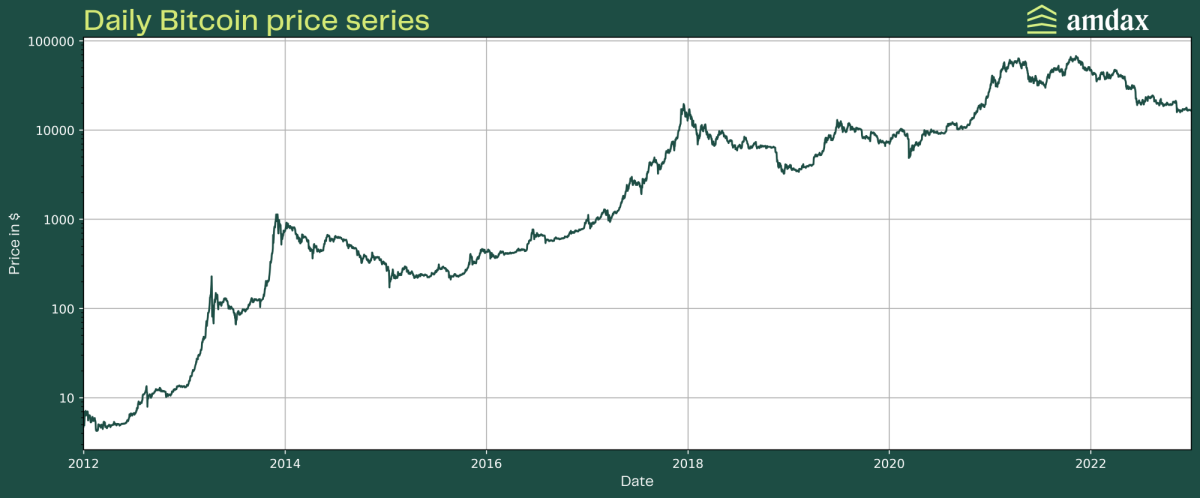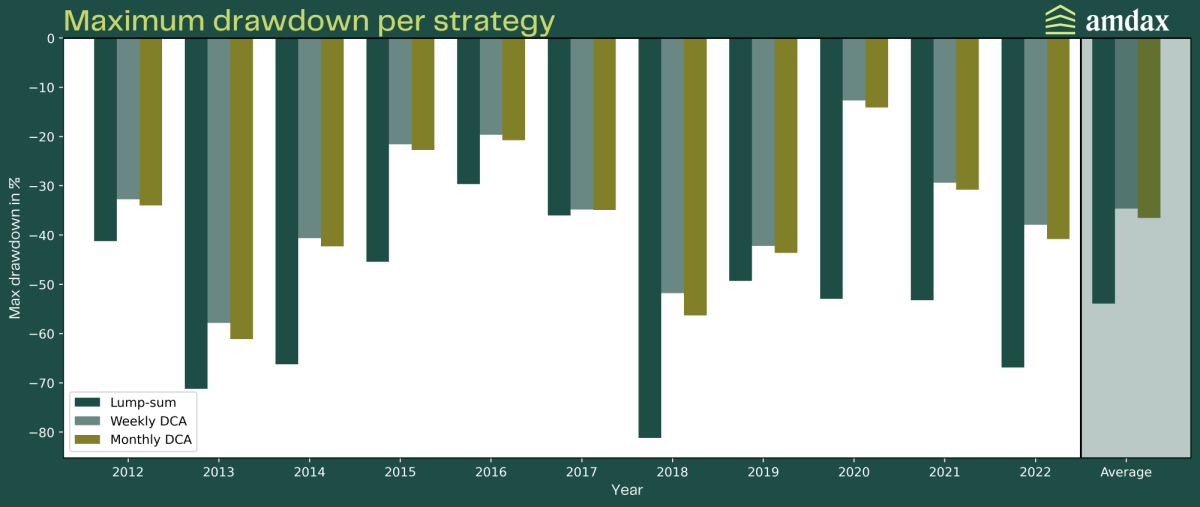Investing in bitcoin: which strategy works best?

16 August 2023
Investing in Bitcoin: which strategy works best?
Suppose you have a substantial amount of money available to invest in bitcoin. Is it a good idea to invest the entire amount at once, hoping for the best? Or are you better off spreading the amount over a longer period, gradually building your portfolio? Different investment strategies have their advantages and disadvantages, and choosing your strategy can have a big impact on your portfolio.
Which
investment strategy works best? We looked into it for you.
Lump-sum: investing with a one-off purchase
Do you invest your available amount in one go? Then the advantage is that you don't have to look after it afterwards. A one-off purchase is also known as a lump-sum or buy-and-hold strategy and is a common strategy among investors. It’s a good way to achieve your long-term financial goals, but also has a major downside.
Many investors decide to invest after an asset has experienced a big rise in value and they make their decision based on emotion. This implies buying at high prices, possibly even at the top of the market. The consequence? The market turns and prices fall, as does the value of your portfolio. After that, it can take months and sometimes even years before the investment becomes profitable.
The bitcoin price below clearly shows that if you bought bitcoin in late 2012, 2017, or 2021, it would have led to a sharp drop in your investment. The big price drop can create doubt, causing you to sell at a loss even before the market rises again.

Are you not worried about violent value fluctuations in your portfolio and are you willing to hold for a long time? Then a one-off purchase based on historical bitcoin price data often turns out to have been the best strategy.
But, in practice, choosing and sticking to one specific buying moment can be tricky. Under the influence of emotions, you are likely to make decisions that get in the way of your strategy. Do you find yourself in this group? Then a different strategy probably suits you better.
Dollar Cost Averaging (DCA): a risk-spreading strategy
To reduce the chances of buying at an unfavorable rate, you can choose to spread your investment amount over a longer period. This strategy is called Dollar Cost Averaging, abbreviated to DCA.
With DCA, you invest an equal amount of money at fixed intervals, regardless of the price or developments in the market. For instance, quarterly, monthly, or (bi-)weekly.
By spreading your deposit over a longer period, you buy at an average price. This prevents you from buying at too high a price at one particular point. In a falling market, you reduce losses and protect your assets. Does the market go up and prices rise? Then DCA can reduce your returns.
The risk of losing returns works both ways. Downside risk if your investment becomes worth less, and upside risk if you miss out on returns.
The maximum price drops for each strategy
It's annoying if you could have made a higher return on your investment, but it's even more annoying if you see your deposit fall in value.
To determine how high the risk of depreciation in your portfolio is for each strategy, we consider the maximum drawdown. This is the largest observed price decrease of an asset in a given period. You can think of this as the worst-case scenario in that period.
For example: if bitcoin's maximum value was $50,000 in 2022 and fell to a minimum value of $25,000 in the same year, the maximum drawdown is -50%.
We calculate the maximum drawdown for the lump-sum portfolio with 1 January as the entry point and for two different DCA portfolios with weekly and monthly investments.
In the chart below, we see the results by year since 2012. It shows that every year, the drop in value of the lump-sum portfolio is greater than the drop in value of the DCA portfolios.

Especially in years with extreme crashes like the COVID crash in March 2020, the difference in declines is sharp. On average, the lump-sum portfolio falls about 20% more from top to bottom than the DCA portfolios. Of the two DCA strategies, the weekly strategy appears to be the least risky.
What about the risk-return ratio?
We now know that you significantly reduce downside risk with DCA. But aren't we missing out on so many returns with a DCA strategy that a one-off purchase is still the better option, despite the higher risk?
To compare the relationship between risk and return, we look at the average return of each strategy relative to the maximum drawdown. This can be calculated using the Calmar ratio.
The higher the Calmar ratio, the better the return relative to risk. In the figure below, we see that the return for the different strategies varies a lot over the past few years. In some years, the DCA strategies outperform the lump-sum strategy, and in other years it is reversed.

Looking at the average over the years, the score for all strategies is almost identical. We can conclude that the risk-return ratio is the same for the different strategies.
Choosing your optimal investment strategy
It
depends on your risk appetite and investment goals. How nervous do you get
about big drops in your portfolio? And how long are you prepared to hold on to
your investment? What do you do when the value of your portfolio has halved?
Some
investors have no problem with that. They don't care about volatility and focus
on the long term. For this group, lump-sum is an effective strategy.
Do
you prefer to avoid risk, or do not want to be constantly engaged with the
market to find the right buying moment? Then the DCA strategy is a suitable
investment strategy. As we see in the data, DCA is a good way to protect
yourself from big losses without sacrificing too much return.
If
you invest in bitcoin, you want to do so simply and safely. Do you opt for a
DCA strategy? Then you would prefer it to be automated. At Amdax, we offer a crypto savings plan, which allows you to easily buy bitcoin or other
cryptocurrencies periodically for a fixed amount.
You
can find the full research article on Medium.

Our website uses cookies
We use cookies to personalize content and advertisements, to offer social media features and to analyze our website’s traffic. We’ll also share information about your usage with our partners for social media, advertising and analysis. These partners can combine this data with data you’ve already provided to them, or that they’ve collected based on your use of their services.